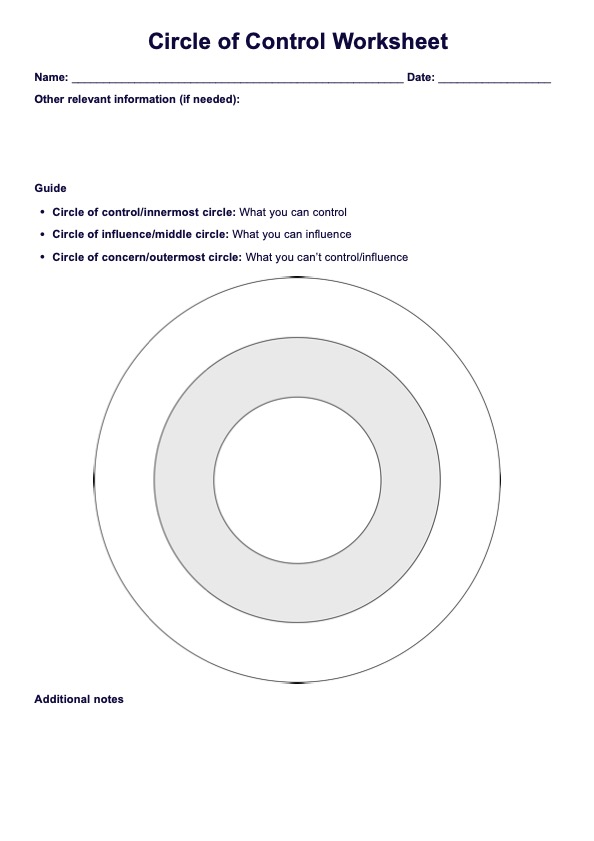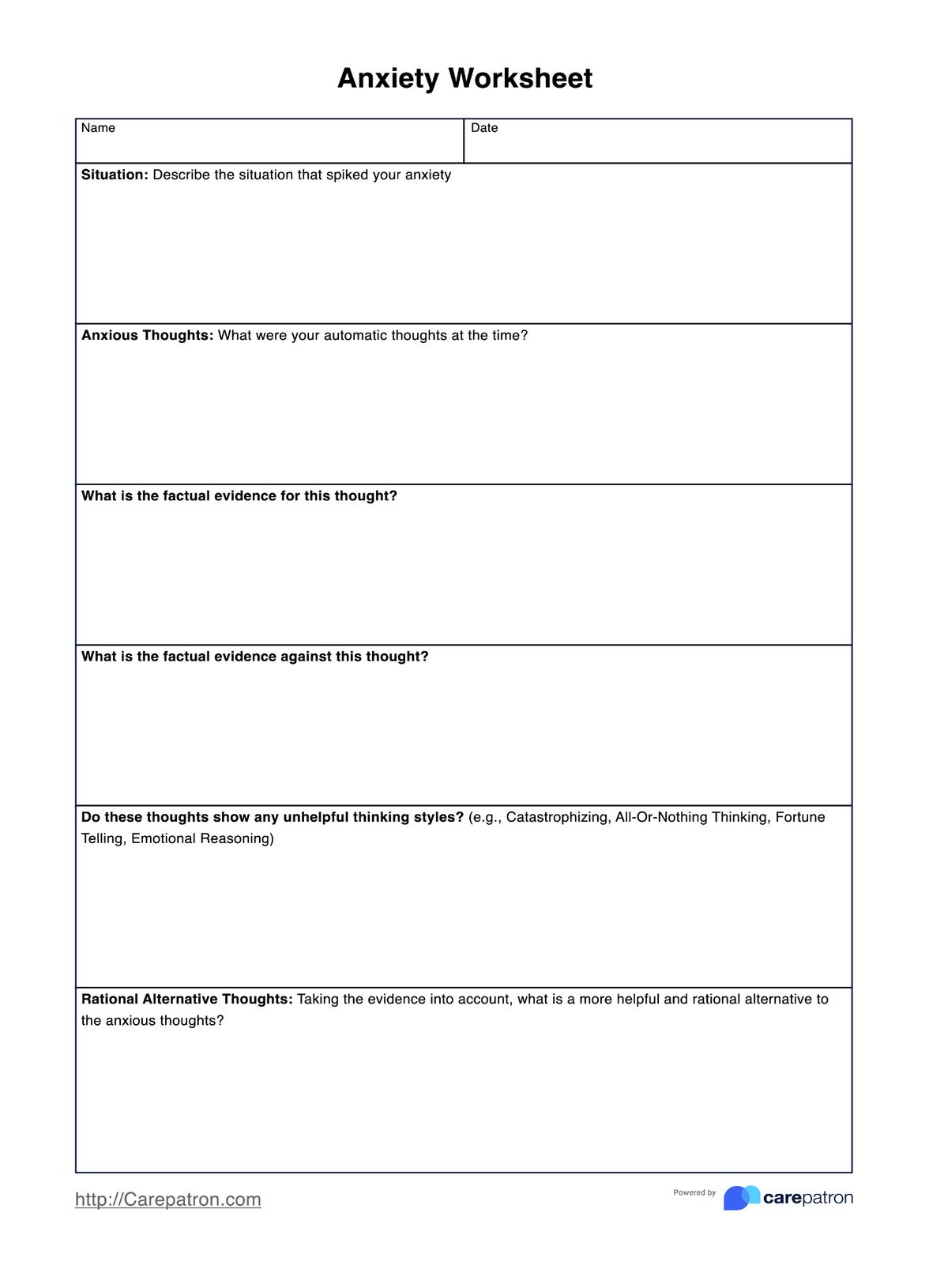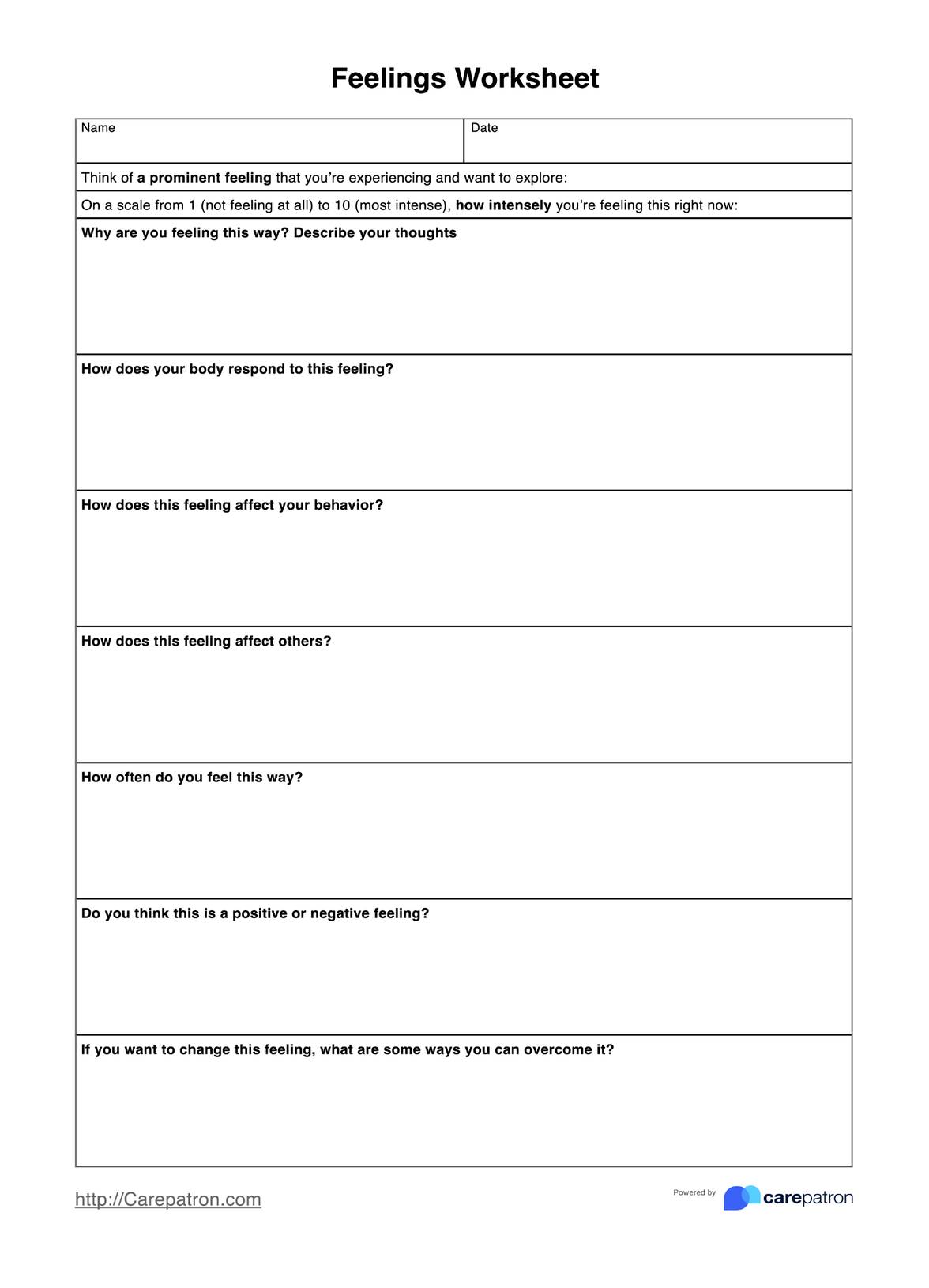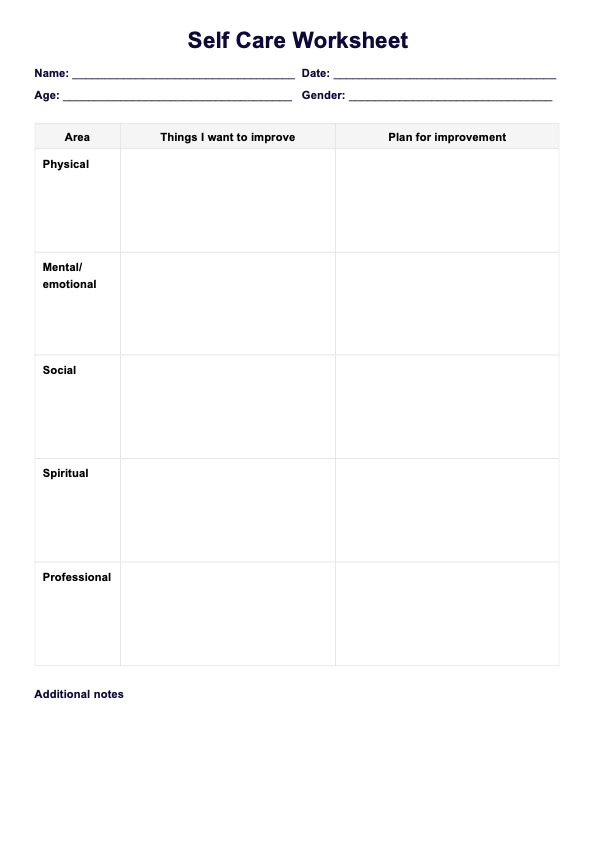CAARS Self Report Long Version
Get access to a free CAARS Self Report Long Version template. Download the PDF for streamlined clinical documentation now.


What is the CAARS Self Report Long Version?
The CAARS Self-Report Long Version (CAARS-S: L) is a clinically validated tool for assessing ADHD symptoms in adults. Developed by Dr. C. Keith Conners and his team at Duke University Medical Center in 1999, this 66-item inventory is one of the key adult ADHD rating scales. It offers healthcare professionals a comprehensive method for determining whether a more in-depth evaluation is warranted. The Conners Adult ADHD Rating Scale is only one of the many tools to measure ADHD, and it's important also to consider other assessments to properly diagnose ADHD in patients.
The CAARS-S: L focuses on both inattentive symptoms and hyperactive-impulsive behaviors, offering a detailed understanding of an individual's experiences. It includes nine empirically derived scales that measure various aspects of ADHD symptomatology, such as sustained attention, self-concept, and emotional regulation. These scales are instrumental in distinguishing ADHD from other psychiatric disorders, such as bipolar disorder or substance use disorders, and provide the foundation for a more detailed clinical assessment.
This tool uses self-report forms on adolescent psychiatry, where individuals rate their symptoms based on their recent experiences. These self-reported ratings are compared against normative data from diverse demographic groups, allowing clinicians to identify deviations that may indicate ADHD.
The CAARS-S: L is designed to complement observer ratings, providing a broader perspective on an individual’s behavior by integrating self-perceived experiences with observations from others. This dual approach enhances the tool’s accuracy and utility in both diagnostic and treatment planning processes.
The CAARS-S: L aids in assessing ADHD symptoms, enabling practitioners to develop tailored interventions and management strategies. By addressing core areas of impairment, the CAARS-S: L facilitates a structured approach to diagnosis and contributes significantly to evidence-based clinical practice. This makes it an indispensable resource for healthcare providers involved in evaluating and treating adult ADHD.
CAARS Self Report Long Version Template
CAARS Self Report Long Version Example
How does it work?
The CAARS Self Report Long Version is a straightforward and efficient tool for healthcare professionals to assess ADHD symptoms in adults. Below are the key steps to effectively utilize Carepatron's CAARS Self Report Long Version template in clinical practice.
Step 1: Access and use the CAARS Self Report Long Version template
To get started, click the “Use template” button in the Carepatron app. This opens the resource, where you can fill it out digitally, customize it to your preferences, or print a physical copy for use during patient assessments.
Step 2: Introduce the template to the patient
Explain the purpose and structure of the CAARS Self Report Long Version to the patient, emphasizing its role in identifying ADHD symptoms. Provide clear instructions on how to complete the form and reassure them about the confidentiality of their responses.
Step 3: Conduct the assessment
Administer the self-report form, either digitally or on paper. Ensure the patient understands the rating scale and responds to all items based on their recent experiences. Create a supportive environment to encourage honest and thoughtful answers.
Step 4: Gather, interpret, and discuss results with patient
Once the form is completed, compare the results to normative data. Identify patterns in the responses to pinpoint ADHD symptoms or related behaviors and share the findings with the patient, ensuring they understand the implications.
Step 5: Provide further patient education
Use the results to educate the patient on ADHD and its impact on daily life. Discuss potential management strategies, treatment options, and next steps, tailoring the recommendations to the patient's needs and concerns.
Scoring and interpretation
As mentioned, the CAARS Self Report Long Version consists of a 66-item questionnaire rated on a 4-point Likert scale, where responses range from 0 ("Not at all true") to 3 ("Very true"). The tool indicates scores across nine clinical scales, such as:
- Inattention/Memory problems
- Hyperactivity/Restlessness
- Impulsivity
- Emotional liability
- Problems with self-concept
- ADHD index
- Inconsistency index
- Executive functioning
- Peer relations
Scores are converted into T-scores, standardizing the results with a mean of 50 and a standard deviation of 10. A T-score of 65 or higher is designated as CAARS-positive (Kasahara et al., 2021), signaling the presence of clinically significant ADHD symptoms. This threshold applies to the CAARS-S (self-report) and CAARS-O (observer report) questionnaires.
These scores help healthcare professionals identify and quantify ADHD-related behaviors, guiding clinical diagnosis and treatment planning. The CAARS-S: L's structured scoring system ensures accuracy and reliability in evaluating adult ADHD symptoms.
Benefits of using this self-report template
The CAARS Self Report Long Version template provides medical professionals a reliable and comprehensive tool for assessing adult ADHD symptoms. Below are the key benefits of using this template in clinical practice.
Accurate assessment through self-report and observer ratings
The CAARS-S: L allows for a combined approach using self-report and observer ratings, providing a well-rounded view of the patient's symptoms. This dual assessment method helps clinicians to accurately identify ADHD and differentiate it from other psychological disorders, ensuring a more reliable clinical diagnosis.
Consistency with DSM-IV criteria and ADHD rating scales
The CAARS-S: L is aligned with DSM-IV criteria for ADHD, ensuring that it measures symptoms based on recognized standards. The inclusion of ADHD rating scales helps clinicians assess both inattention and hyperactivity, providing a comprehensive understanding of the patient's condition in line with established diagnostic guidelines.
Enhanced diagnostic accuracy with factor-derived subscales
The template includes factor-derived subscales that assess key areas such as sustained mental effort, impulsivity, and emotional regulation. This structured breakdown improves diagnostic precision, helping clinicians address specific ADHD symptoms and reduce the likelihood of random or careless responses during the assessment process.
Reference
Conners, C. K., Erhardt, D., & Sparrow, E. (1999). Conners’ Adult ADHD Rating Scales (CAARS) technical manual. North Tonawanda, NY: Multi-Health Systems.
Kasahara, S., Niwa, S.-I., Matsudaira, K., Sato, N., Oka, H., Fujii, T., Konno, S.-I., Kikuchi, S.-I., & Yamada, Y. (2021). High attention-deficit/hyperactivity disorder scale scores among patients with persistent chronic nonspecific low back pain. Pain Physician, 24(3), E299–E307. https://pubmed.ncbi.nlm.nih.gov/33988951/
Commonly asked questions
The CAARS Self-Report Long Version (CAARS-S: L) is among the most accurate self-assessment tools for ADHD due to its alignment with evidence-based ADHD rating scales. It provides comprehensive insights through self-reported data and standardized scoring methods.
CAARS Self-Report Long Version (CAARS-S: L) scores are converted to T-scores, with values above 65 indicating clinically significant ADHD symptoms. These scores help identify symptom severity and guide clinicians in the diagnostic process.
The CAARS Self-Report Long Version (CAARS-S: L) demonstrates high accuracy due to its strong psychometric properties and validation against normative data. It is widely recognized as a reliable tool for diagnosing and assessing ADHD symptoms in adults.


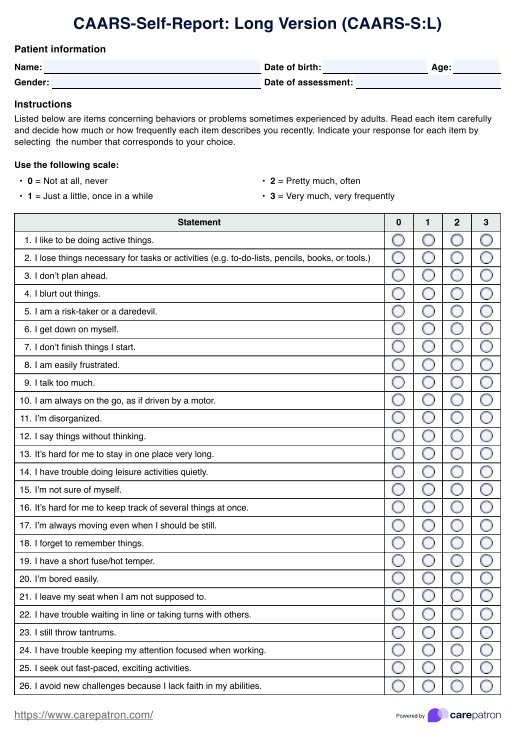
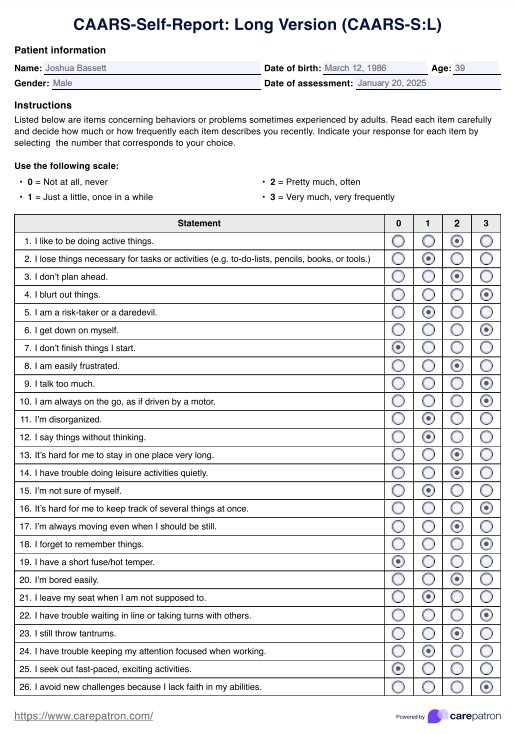

















-template.jpg)



















































































